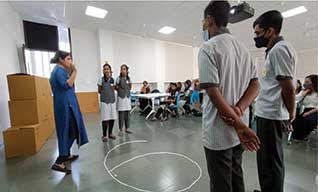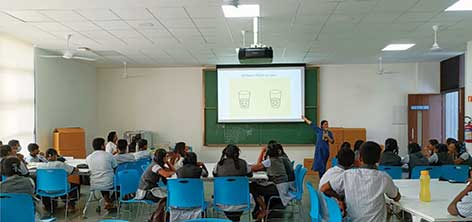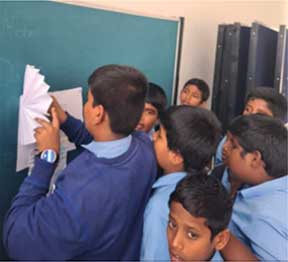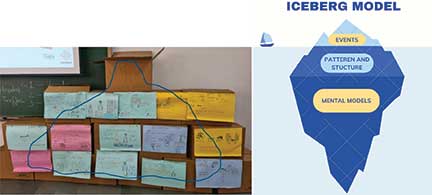Divya Sharma, Smriti Tiwari, Neha Khandekar, and Rinan Shah
Recently we concluded COP-27, which is one of the largest gatherings to engage with the current complex issue of climate change. Several youth-led coalitions and young leaders from around the world have time and again come together in these global meetings to demand action from country leaders and representatives. The urgency is felt loud and clear. The question is what is missing between our intention and action.
If we look deeper into environmental problems, we may find that there is a fundamental disconnect with regard to how we perceive the reality of the situation. There is an inherent limitation within us as humans to make sense of a complex phenomenon. As an individual we might never be able to understand what large infrastructure can do to river or forest ecosystems? Or, how urban floods might be linked to something at a global scale as well as to something that has been happening slowly from the past 80 years locally? Or how our current actions can change long-term future trajectories?
Many of these limitations are becoming detrimental to us as well as the survival of many other species with whom we share this planet. It’s almost like cutting the branch we are sitting on!
Can we become deliberate in understanding each other’s points of view and facilitate the processes of understating the whole truth? This led to the birth of the vision of ’breaking silos’ with the intention that we can unveil our own shortcomings and break the inertia for more collaboration in the spirit of understanding the problem and problem solving.
These motivations were an impetus to participate in the “Rivers of Life” festival at Azim Premji University, Bengaluru on 15 November 2022 and organize the workshop titled “Unpacking Wicked Problems in India in Water”.
Co-learning in workshop mode
Tell me and I forget, teach me and I may remember, involve me and I learn. – Benjamin Franklin
Human intelligence or cognitive ability evolves through continuous engagement with peers and the environment. Rote learning is useful in remembering concepts and analyzing them, whereas active learning, which happens in a workshop, leads to critical thinking and reflective engagement. A workshop becomes a space where individual minds are nudged to focus on one specific idea. The collaborative engagement paves way to collective imagination and innovation.
The workshop “Unpacking Wicked Problems in India in Water” was designed to engage school students and to reflect on three ideas/concepts: 1) Perception of reality differs because of positionality, 2) The whole is more than the sum of the parts, and 3) A complex problem can be unpacked and traced back to issues in values and norms.
Activities and outcomes
To engage school students with intricate ideas, games and activities were designed. We started with simple activities which involved demonstration and guessing games and then progressed to team activities that were more rigorous in terms of imagination, cognition, and reflectivity to unpack complex problems.
Activity 1: Different perceptions
Different people can see the same thing but still perceive it differently. Perception is the interpretation of reality through one’s mind construct, embedded in past learnings and expectations. Collaboration needs a cognizance that alternate perceptions exist of the same reality. The understanding of alternate views creates fertile ground that enables exchange of thoughts, imagination and innovative ideas.
The first activity warmed up the students to become more open in receiving counter views and conflicting thoughts from the peer group. It encouraged them to go beyond right or wrong and respect each other’s world views.
We drew a 6 on the ground and asked a few students to split into two groups and view the figure – half the group saw it as a 6 and the other half saw it as a 9. The rest of the students were asked which group was right. There was unanimity that both were right. That resonates with the concept that two contrasting ideas about the same reality can be different but also right at the same time in their own sense.

Students trying to understand diversity in perspectives (Rivers of Life, Azim Premji University, Bengaluru)
Similarly, students were asked whether the glass was half empty or half full, invoking the idea of difference in perception.

(Rivers of Life, Azim Premji University, Bengaluru)
We then progressed to ‘guess the animal’ series of games in which different objects were shown as part of the puzzle to guess the animal. The game activated the imagination and connection building of the students.

The idea of diversity in perception and connection building set the stage for the next two activities where imagination and collaboration were required.
Activity 2: The whole is more than the sum of the parts
Many times we can perceive only a part of reality. Various aspects stay hidden or are beyond one’s cognitive ability or ignorance. The next activity helped students realize that what we see might only be a part of the truth and the whole might be entirely different from what the parts look like.
The whole is more than the sum of the parts. – Aristotle
Borrowing from the story of the blind men and the elephant, we asked the students to create an animal from self-drawn pictures of five disconnected objects – a wall, a rope, a fan, a snake, and four tree stumps. Students were divided into groups and were encouraged to discuss and create an animal. After some quick brainstorming, the students came up with the elephant shared below with an extra dose of creativity of not a hand drawn fan but a paper folded fan that represented the ear of the elephant.

The elephant is not the snake, nor the fan, nor the log, nor the wall, nor the rope. Neither is the elephant the sum of all of these things put together.
Activity 3: Unpacking the Bengaluru floods
A hazard like floods has a differentiated impact on people and the environment. An urban flood is often a manifestation of diverse systemic failures in infrastructure and institutions involved in an urban space. The next activity nudged the students to think systematically in unpacking the root cause of urban floods by focusing on one specific question at a time.
As a closing activity, we introduced the group to the incident of the Bengaluru floods in August 2022, using a series of pictures depicting incidents and situations that emerged during the floods.
We divided the students into five groups of 8-10 students, where each group picked a specific storyline to deconstruct the problem of the flood. They were then asked to choose any one situation they found important and by using chart papers and coloured pens, each group had to create three layers by trying to answer the question: 1) What? – defining the problem they saw in the picture. 2) Who? – people/institutions involved in creating/adding to the problem identified in the previous question and 3) Why? – underlying thinking of the people or institutions identified in the previous question. The groups worked on each question on chart papers and came up with insightful observations as we nudged them to dig deeper each time.

Students identified five diverse impacts of the Bengaluru urban floods – livelihood, domestic water scarcity, agriculture, hospitals and healthcare, and traffic. The first group engaged with the livelihoods of vendors. Issues like not having space to carry out their business impacting their livelihood and how this further affects the credit and debit process. Questions regarding how one can buy from another vendor and not their regular vendor also showed up. Carelessness and lack of awareness of the people, lack of plans by institutions and the government were highlighted. Irregular, unseasonal rainfall, removal of trees for urbanization and pollution were seen as causes of the problem.
Domestic water scarcity was the issue the second group wanted to address. Since most of their households (students were from the rural part of Bengaluru) did not have private water connection, they fill water from the public tap. As for drinking water, they use the water ATMs, since the water they get is not potable. During floods, carrying water might get hindered. The government is not proactive in sanitation which makes availability of drinking water difficult. Blocked roads restrict movements. Mosquitoes also breed in stagnated water. According to them, the Panchayat members are lazy and careless about the drainage system and think only about money. They are certain that even if one approaches the Panchayat they will not listen. People also litter plastic everywhere.
The third group picked up the issue of agriculture. They did a macro analysis of farmer suicides, markets, economic condition of the nation, increase in demand, and malnutrition leading to larger impacts on the nation. The causes they pointed out were global warming, acid rain, and dam construction. The creation was attributed to profit, inflation and multinational corporations.
Floods affecting hospitals and healthcare was the topic chosen by the fourth team. They identified that the mobility of the patients and healthcare professionals becomes restricted during floods. Even ambulances will find it difficult to reach their destinations during emergencies. One cause identified by them was that the government permitted cutting of trees to extend roads and this is increasing instances of floods since there is no space for water to flow. BBMP (Bruhat Bengaluru Mahanagara Palike), institutions and businessmen are involved in causing floods. For the third question, they answered that there seems to be a lack of empathy and humanity.
Traffic, the eternal issue in Bengaluru, was picked by the fifth group. Pictures of private buses and cars and electric poles falling were displayed. Factories were seen as the cause of this issue. The students interestingly pointed out that factories produce plastic but there is no choice as it is required for our daily use. By the time the students came to the third chart/conclusions which had the why question, they were uninhibited about pointing out the facts which not only dealt with the efficiency of the system but also included the values of empathy, humanity, care, responsiveness, and others.

The group that worked on livelihoods captured subtle nuances such as a customer feeling bad for buying from a different street vendor because the regular one didn’t show up while the group that worked on agriculture went into details such as malnutrition as well as economic markets suffering. The students were also able to see that all these consequences are not only due to natural causes such as rainfall, global warming, etc., but are also the result of (in) action by governments, institutions, businesses, and so on. The most interesting insights came from answers to the third question. They came up with insights such as greed, laziness, lack of empathy and humanity as well as the lack of choice for some individuals that may be causing the problem but have to earn their livelihood this way.
After this exercise was completed,the students were asked to put their charts on cardboard boxes arranged in a pyramidal manner. In this way, we were able to show them that often many of the problems we face have the same underlying causes and are motivated by similar norms and values. Therefore, sustainable change will be possible when we are able to come together to discuss problems and work at all levels of the pyramid to solve them.
As a team of facilitators, this interaction with the young minds of today left us re-energized and inspired to continue to do what we do and do it better each time. We hope to organize more such workshops for different age/professional groups.
Acknowledgement: This workshop was part of the Rivers of Life festival, organized by Azim Premji University. It was facilitated by the Indian Youth Water Network along with Socrates Foundation for Collective Wisdom to engage with school students to make them aware of different ways of thinking about ‘wicked’ problems that usually have several underlying causes and no easy, straightforward solutions. To get them thinking, we showed them sketches done by our collaborator Srinivas Mangipudi on various situations that could occur during a flood – a flooded medicine shop, a stuck ambulance, a food delivery service by boat and a child rejoicing that he doesn’t have to go to school.
Workshop conceptualization and structure: Divya Sharma (Azim Premji University)
Activity design: Divya Sharma, Neha Khandekar (Indian Youth Water Network), Smriti Tiwari, Srinivas Mangipudi, Arvind Balasubramanian (Socratus Foundation for Collective Wisdom)
Conduction: Divya Sharma, Smriti Tiwari, Neha Khandekar
Facilitation: Rinan Shah, Satwiki Adla (Ashoka Trust for Research in Ecology and the Environment)
Divya Sharma is a faculty member at School of Development, Azim Premji University. She can be reached at divya.sharma@apu.edu.in.
Smriti Tiwari is a Program Associate at Socrates Foundation for Collective Wisdom.
Neha Khandekar is a cofounder of Indian Youth Water Network.
Rinan Shah is a PhD scholar at The Academy for Conservation Science and Sustainability Studies, Ashoka Trust for Research in Ecology and the Environment.
